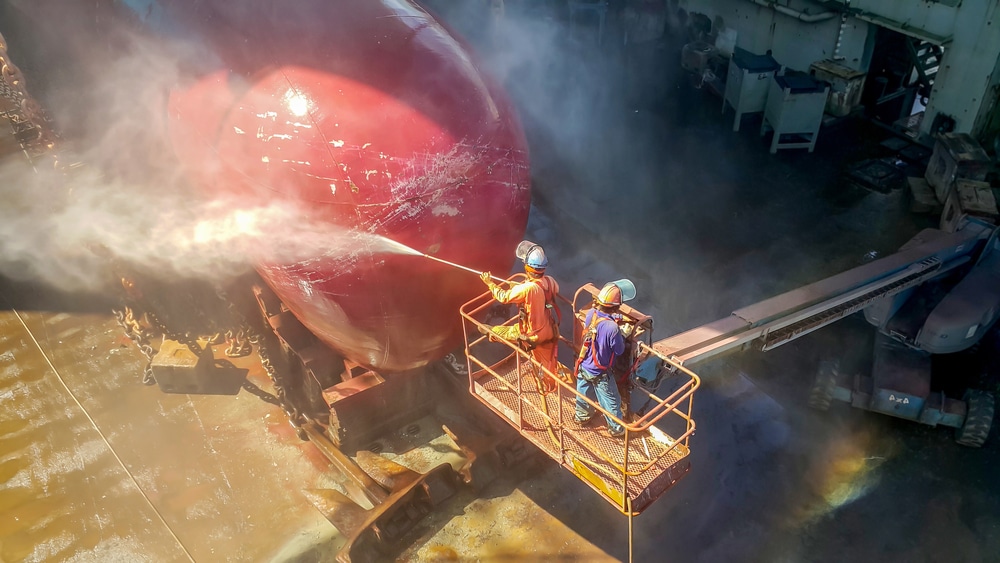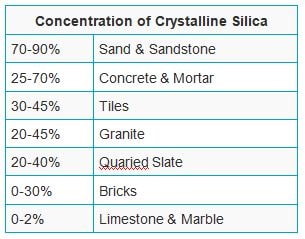
Each year, millions of workers in the United States are exposed to crystalline silica. Many of these workers do not know that this common mineral can lead to a host of health problems, including incurable diseases like silicosis and lung cancer. At Maritime Injury Guide, our maritime injury lawyer wants you to be aware of the risks of crystalline silica so that you can take measures to prevent exposure.
In this post, you will find information about the mineral, the dangers, and what you can do to protect yourself. If you have questions about toxic chemicals or substances, don’t hesitate to contact Maritime Injury Guide.
What is Crystalline Silica?
Crystalline silica is a mineral that is in most rocks. It is present in sand, stone, brick, concrete, and mortar. It is most commonly found in quartz, which is one of the most common minerals found on the surface of the Earth.

When workers in construction or mining cut, saw, or grind rocks crystalline silica particles are released into the air in the form of silica dust. Workers in the maritime industry commonly use silica sand as an abrasive to clean ship hulls or remove paint. This also releases silica dust into the air.
Why is Silica Dust Dangerous?
Silica dust is respirable, meaning you can inhale the fine particles when breathing. Breathing in silica dust is dangerous because the particles can lodge themselves in the soft tissues of the lungs. This causes inflammation, scarring, and nodules – all of which can impact breathing.
Silica dust can also cause a variety of lung and airway diseases, autoimmune disorders, renal disease, and other health complications. The Occupational Safety and Health Administration (OSHA) lists the diseases most often linked to silica dust exposure as:
- Silicosis
- Lung Cancer
- Pulmonary Tuberculosis
- Chronic Obstructive Pulmonary Disease (COPD)
- Kidney Disease
What is Maritime Silicosis?
As a maritime injury lawyer, the most common questions about maritime silica exposure relate to silicoses. Maritime silicosis often develops after months or years of exposure to silica dust. Workers who sandblast or use abrasives may experience high concentrations of silica dust, especially if they work in confined areas.
Silicosis is an incurable lung disease that progresses, or gets worse, over time. Many workers do not experience symptoms of silicosis for up to 15-20 years after initial exposure. As a result, it is often difficult to link silicosis to occupational hazards. The most common symptoms of silicosis include:
- Shortness of breath
- Fatigue
- Chest pain
- Weight loss
- Edema (swollen legs)
- Fever
- Persistent productive cough
The Centers for Disease Control and Prevention (CDC) defines silicosis as a pneumoconioses, or a group of interstitial lung diseases. These diseases are the result of inhaling respirable dust into the lungs. In addition to silicosis, asbestosis and coal workers’ pneumoconiosis (black lung) are also in this category of disease.
Silicosis is a lung disease itself, but it can also compromise your immune system to dangerous levels. Silicosis also puts you at risk for developing additional health problems, including COPD, tuberculosis, or lung cancer.
Is Silicosis Preventable?
Silicosis is 100 percent preventable by following proper safety and health measures. In 2018, OSHA developed new “Respirable Crystalline Silica” standards, which are applicable to workers in all industries, including the maritime industry. The new standards require employers to do the following:
- Determine if any worker is exposed to silica dust above the exposure limits set by OSHA, which is 25 micrograms per cubic meter of air.
- Create a written exposure control plan.
- Train workers on the dangers of silica dust exposure and how to prevent exposure.
- Limit access to areas where silica dust levels are above exposure limits.
- Use housekeeping measures to reduce the amount of dust in the air.
- If silica dust is present, employers must protect workers by providing adequate respirators.
- Workers who are exposed to silica dust above the exposure limits for 30 days or more per year must be provided a medical exam every three years. Furthermore, the exam must include lung function tests and a chest x-ray.
In addition to these guidelines, workers engaging in certain occupations, such as sandblasting, are subject to all other applicable OSHA guidelines. For example, employers must provide adequate ventilation.
Have You Been Diagnosed with Maritime Silicosis? Contact a Maritime Injury Lawyer
Despite OSHA guidelines and CDC recommendations, employers still fail to prevent silica dust exposure. In fact, estimates suggest that two million workers in the U.S. are currently vulnerable to developing silicosis.
If you have received a diagnosis of silicosis, you may be one of the many people who were not provided with adequate protection from silica dust. However, The Jones Act and other maritime laws exist to protect workers like you from the negligence of others. If your employer failed to keep you safe, then you may have an actionable claim.
To find out more about silicosis and your legal rights, contact the maritime injury lawyer at Maritime Injury Guide. Our legal team can certainly help you understand and protect your legal rights. Complete our online contact form to get started.
Sources: